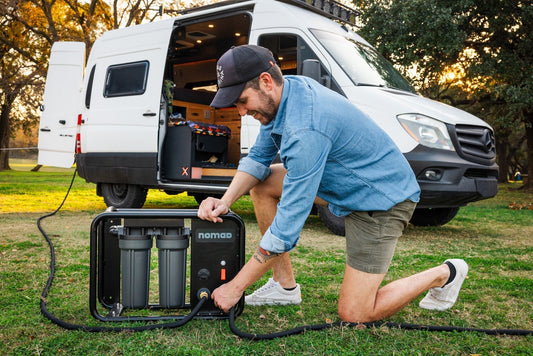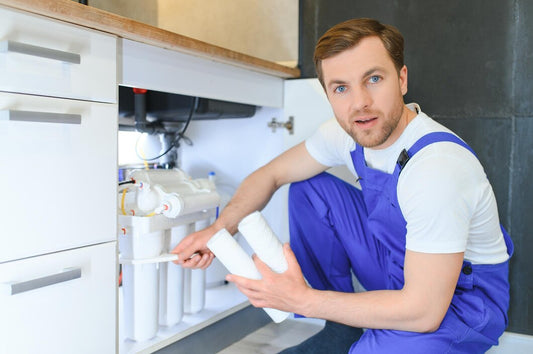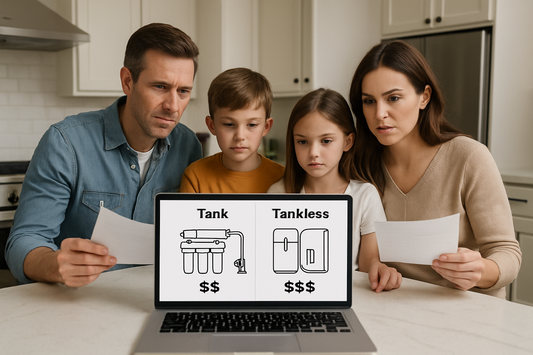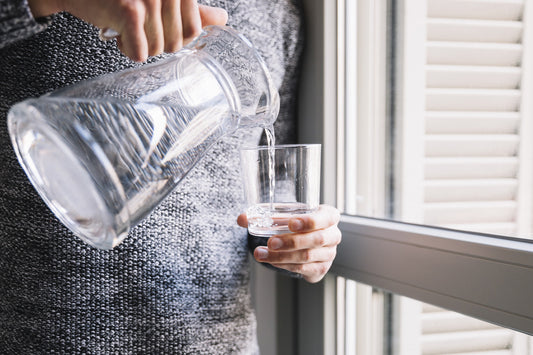Choosing the right water filter shouldn't require a chemistry degree. Whether you're dealing with chlorine taste, hard water stains, or want peace of mind about contaminants, this guide cuts through the confusion with clear comparisons and quick decision tools.
Why Your Water Filter Choice Matters More Than Ever
The Hidden Cost of Poor Water Quality
Every day, your family consumes water that may contain chlorine, lead, pesticides, or bacteria. These contaminants don't just affect taste—they impact your health, your home's plumbing, and your wallet through bottled water purchases.
Health Benefits You'll Notice Immediately:
- Cleaner taste and odor elimination
- Reduced skin and hair dryness from shower water
- Lower risk of gastrointestinal issues
- Protection from heavy metals like lead and mercury
Financial Impact Analysis: A quality whole house water filter costs $300-1,500 upfront but saves the average family $600+ annually on bottled water while protecting appliances from mineral buildup damage.

Quick-Start Filter Selection: Find Your Match in 3 Steps
Step 1: Identify Your Primary Water Issue
🔍 Quick Water Assessment:
- Taste/Odor Problems: Chlorine, sulfur, or metallic flavors → Activated Carbon Filter
- Hard Water Stains: White buildup on faucets, dry skin/hair → Water Softener + Filter Combo
- Health Concerns: Unknown contaminants, old pipes → Reverse Osmosis System
- Budget-Conscious: Basic improvement needed → Pitcher or Faucet Filter
- Whole-Home Solution: Multiple issues throughout house → Whole House Filter System
Step 2: Budget Planning - Real Costs Breakdown
| Filter Type | Initial Cost | Annual Maintenance | 5-Year Total | Best For |
|---|---|---|---|---|
| Pitcher Filter | $25-60 | $120-180 | $625-960 | Renters, basic needs |
| Faucet Mount | $50-150 | $60-120 | $350-750 | Kitchen-only solution |
| Under-Sink | $200-500 | $80-150 | $600-1,250 | Dedicated clean water |
| Whole House | $500-1,500 | $100-300 | $1,000-3,000 | Complete home coverage |
| RO System | $300-800 | $150-250 | $1,050-2,050 | Maximum purification |
Step 3: Installation Difficulty Scale
DIY-Friendly (1-2 Hours):
- Pitcher filters: No installation
- Faucet-mount filters: Basic tool requirements
Moderate DIY (2-4 Hours):
- Under-sink systems: Basic plumbing skills needed
- Countertop units: Minimal modifications required
Professional Installation Recommended:
- Whole house systems: Requires main line access
- Complex RO systems: Multiple connection points

Image by freepik
How to Choose Water Filter for Home: Complete Type Breakdown
Activated Carbon Filters: The Versatile Choice
What They Remove: Chlorine, bad taste, odors, some pesticides and industrial chemicals
Perfect For: Most city water improvement needs, budget-conscious households
Maintenance: Replace cartridges every 2-6 months depending on usage
Reverse Osmosis: Maximum Purification
What They Remove: 95%+ of dissolved solids, heavy metals, bacteria, viruses, fluoride
Perfect For: Well water, areas with known contamination, health-conscious families
Considerations: Slower water production, requires storage tank, wastes some water
Whole House Water Filters: Complete Coverage
What They Remove: Sediment, chlorine, some chemicals from every tap
Perfect For: Large families, hard water areas, protecting appliances
Bonus Benefits: Softer skin and hair, longer appliance life, better-tasting ice
UV Light Systems: Bacteria Elimination
What They Remove: 99.99% of bacteria, viruses, and other microorganisms
Perfect For: Well water users, areas with biological contamination concerns
Important Note: Requires pre-filtration for sediment and chemicals
Water Filter Comparison Chart: Side-by-Side Analysis
Contaminant Removal Effectiveness:
- Chlorine: Carbon (Excellent), RO (Excellent), UV (Poor)
- Heavy Metals: Carbon (Good), RO (Excellent), UV (None)
- Bacteria/Viruses: Carbon (Poor), RO (Excellent), UV (Excellent)
- Pesticides: Carbon (Good), RO (Excellent), UV (Poor)
- Minerals: Carbon (Preserves), RO (Removes), UV (Preserves)
Maintenance Made Simple: Your Filter Care Schedule
Monthly Tasks:
- Check water pressure and flow rate
- Inspect visible filter housing for leaks
- Note any taste or odor changes
Quarterly Tasks:
- Replace standard carbon filter cartridges
- Clean pitcher and faucet filter housings
- Test water quality if desired
Annual Tasks:
- Replace RO membranes and specialty cartridges
- Professional system inspection for whole house units
- Sanitize UV light systems

Image by hryshchyshen
Special Considerations for Off-Grid and RV Living
For those seeking portable solutions or off-grid water independence, consider gravity-fed systems and portable UV sterilizers. These systems work without electricity and handle varying water sources effectively.
Top Portable Options:
- Gravity-fed ceramic filters for camping
- Portable UV sterilizer pens for travel
- Compact RO systems for RV installations
Frequently Asked Questions
How often should I replace my water filter?
Most carbon filters need replacement every 2-6 months, while RO membranes last 2-3 years. Usage volume and water quality determine exact timing—reduced flow rate signals replacement time.
Do water filters remove beneficial minerals?
Carbon filters preserve minerals while RO systems remove them. If using RO, maintain mineral intake through diet or consider a remineralization stage.
Can I install a water filter myself?
Pitcher, faucet-mount, and most under-sink filters are DIY-friendly. Whole house systems typically require professional installation due to main water line connections.
What's the most cost-effective water filter?
For basic chlorine removal, under-sink carbon filters offer the best value. For comprehensive filtration, whole house systems provide the lowest per-gallon cost long-term.
Making Your Final Decision: Action Steps
Before You Buy:
- Test your water to identify specific contaminants
- Calculate 5-year costs including maintenance
- Measure installation space and check compatibility
- Read reviews from verified purchasers
Ready to Upgrade Your Water Quality? Whether you need a simple under-sink water filter for better-tasting coffee or a comprehensive whole house filtration system for complete home coverage, the right filter transforms your daily water experience.
Your Path to Cleaner Water Starts Today Don't let another day pass drinking subpar water. With this comparison guide, you have everything needed to choose confidently. Your family's health, your budget, and your peace of mind all benefit from making the right water filter choice now.





